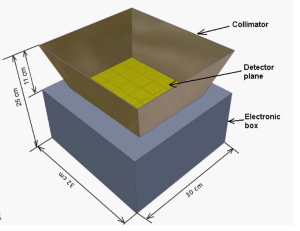Instruments
Main content
The miniature X-ray and gamma sensor (MXGS) and University of Bergen
The University of Bergen will, in collaboration with the Norwegian firm Ideas Gamma Medica and the Space Research Center, Polish Academy of Science (SRC PAS), Warszawa, Poland, design and build the detector boards and read-out electronics for MXGS including the High Voltage and Low Voltage Support. The MXGS will be optimized to detect occurrence frequency of TGFs and obtain spectral characteristics at the highest time resolution as possible.
The scientific requirements for MGXS are:
| Energy range | <10-500 keV |
| Energy resolution | <10% @ 60 keV |
| Quant eff @100 keV | 0.94 |
| Relative time accuracy | < 10 microsec |
| Burst rate capability | 500 cnts/ms |
| Background level | ~1 cnt/ms (10-500 keV) |
| Trigger | Bi-directional link to MMIA |
| Auroral events - peak rates | 10^6-10^7 cts/s for few min |
| Mounting | Nadir-pointing |
| Field of View | 80*80 deg^2 |
Based on modeling results during the Phase-A study the minimum MXGS detector area is determined to 576 cm^2, required for detection of a factor 10-20 more TGFs than BATSE and twice as many as RHESSI observed. The base line concept for Phase B has been increased to 1048 cm^2, to explore imaging possibilities. The energy range has been selected to <10 keV - 500 keV to utilize the photoelectric absorption of lower energy X rays (<20 keV) to determine the altitude of TGF production. As no TGF measurements below 20 keV have been made, the production altitude is still an open question. Suggestions in the literature vary from <20 km (Dwyer et al., 2005) to 60 km (Nemiroff et al., 1997). Combined with modeling of expected X-ray fluxes at ISS altitudes given different TGF production altitudes, the measurements from ASIM/MXGS will help us resolve this question and thereby be able to examine different theories for TGF production. A conceptual presentation of MXGS is shown below. The detector plane is protected against the background radiation by a passive shield and the FOV is defined by a hopper shaped collimator. The DPU and the shielding is the responsibility of University of Valencia, Spain.
For the 1048 cm^2 detector plane Cadmium-Zink-Telleriud (CZT) detectors will be used. CZT has a high quantum efficiency for hard X- and gamma-rays and can be operated close to room temperature (typically +10ºC). Combined with a fast Application Spesific Integrated Circuit (ASIC) based read-out system (6 microsec) the MXGS will give the time history and spectra of TGFs during their expected lifetime of 1-5 ms. The read-out system will also provide an event trigger to flag observations of bursts and to trigger the MMIA cameras. Coupled to ASICs, a CZT detector system is compact and ideally suited for space experiments.
References
Dwyer, J. R. and D. M. Smith, A comparison between Monte Carlo simulations of runaway breakdown and terrestrial gamma-ray flash observations, Geophys. Res. Lett., 32, L22804, doi:10.1029/2005GL023848, 2005.
Nemiroff, R. J., J. T. Bonnell, and J. P. Norris, Temporal and spectral characteristics of terrestrial gamma flashes, J. Geophys. Res., 102, 9659, 1997.
